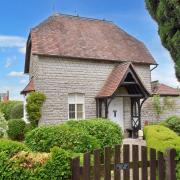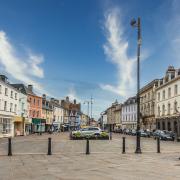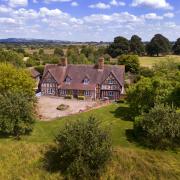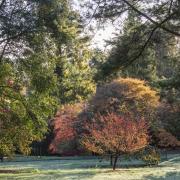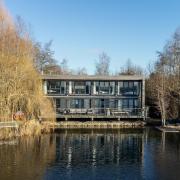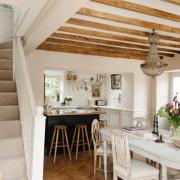After decades of being overshadowed by their more famous neighbour, Westonbirt School Gardens are beginning to live up to their listed status thanks to a gradual programme of restoration.
Crumbling stonework has been repaired, borders replanted and a long battle against Japanese knotweed appears to have been won.
It’s a slow process because funding has to be raised by The Holfords of Westonbirt Trust, set up in 2006 to mastermind conservation of the gardens and the house, which is now a private school.

The house and gardens were once the private home of Robert Holford, founder of the nearby National Arboretum – the arboretum’s rides radiate from the house and the now internationally renowned collection of trees was originally just parkland for the house.
Robert laid out many of the garden’s most important features, among them the Italian Garden and the lake, and was responsible for planting the magnificent specimen trees, something that was continued by his son, George.

In the roughly one-acre Italian Garden, Head Gardener Alix Chalk has been overhauling the planting, particularly in the long exotic borders where plants that are borderline hardy revel in the warmth of the boundary wall.
‘The exotic borders were getting a bit scrappy,’ she recalls. ‘There were some nice salvias, which I’ve kept, but lots of huge wall shrubs that had got really over-sized.’

These have been removed or tamed, while dahlias and exotics, such as cannas, amaranthus and melianthus have been added where they mingle with foxgloves, pittosporum, clematis and roses.
‘I was just amazed at what actually survives the winters – all the dahlias, the cannas, and the hedychiums. I leave them all in and just mulch them because it's quite a sheltered microclimate.’

At either end of the borders are original wall-trained magnolias with pink, bowl-shaped spring flowers, just two of the plants with a long history.
More original plants are found in the Camellia House, a beautiful building, set between the exotic borders, which was renovated some years ago.
‘The camellias were not in a great state when I started,’ says Alix. ‘So, I've been slowly building them up, feeding them properly, and pruning properly.’

Inspired by old photographs from the 1900s showing the interior of the Camellia House draped in wisteria and other climbing plants, she’s added some seasonal interest in the form of sweet peas, heliotrope and pelargoniums left over from planting up the urns. One of the things that is performing particularly well is a self-sown thalictrum, possibly the result of using homemade compost, that now towers over everything else.
The new planting has proved a real success, adding interest at a time when the camellias are pretty dull, and Alix is planning to continue with possibly a different colour theme each year.
Outside, deciding she didn’t like the pink and yellow combination of roses underplanted with sisyrinchium and evening primrose, Alix has replaced the evening primrose with geraniums, nepeta and Alchemilla mollis in the rose beds.

The twin herbaceous borders were replanted some years ago with colours moving from hot tones to cool shades. These deep borders now have a long season of colour from a mixed planting that includes Cephalaria gigantea, hemerocallis, Japanese anemones, Veronica longifolia and perovskia
Two new borders either side of the dolphin ponds were originally created by Alix as a ‘holding space’ for plants that needed to be moved out of the way of builders repairing stonework. However, such was the success of flowers against the dark yew hedge, the beds have been kept.
Scarlet Fuchsia ‘Mrs Popple’, grown from cuttings, and Dahlia coccinea a gift from designer Mary Keen, who used to advise on the garden, are mixed with perovskia, and amaranthus, which drips down over the wall. Self-sown purple loosestrife is tolerated – ‘I'm quite into allowing wilder plants and having the formal structure but kind of chaos within it.’

The long Victorian iron pergola, once buried under a mass of brambles and nettles, has been restored and is now planted with roses and clematis.
Either side, the fernery with its original Pulhamite artificial rocks rearranged, is once again full of soft fronds with planting that includes dryopteris, Matteuccia struthiopteris (the shuttlecock fern) and Polystichum setiferum (the soft shield fern). Pops of colour come from snowdrops early in the year followed by white foxgloves.
The loss of a large oak means the area is now rather too sunny for the ferns and Alix is hoping that this will be rectified by new trees, including a Quercus acrophobia, that were given to the garden by the arboretum after a plant-hunting trip to California.

More surplus plants have been put to good use in what are now known as The Coronation Rose Beds. Overlooked by the headmistress’ office, the original roses in them had become very poor and were replaced with 60 bushes bought from a flower farm that was moving into edible flowers rather than roses.
‘They were really good quality and cheap,’ says Alix, who works one day a week at Westonbirt along with six volunteers.
Replacing most of the soil and cossetting the roses has seen all but one thrive and they are now underplanted with Knautia macedonica, Nepeta ‘Six Hills Giant’ and bulbs, although not tulips, which Alix has found impossible to grow due to the resident squirrels.
‘The first year I was here, I planted loads of tulips and none of them came up,’ she recalls.
One of the biggest renovation projects recently has seen the overgrown and leaking ornamental lake relined and replanted.

Originally put in by Robert Holford, it had been in a sorry state for some time – ‘It was full of brambles and there was Japanese knotweed growing all around it. Apparently, we have our own Westonbirt type that’s extra vigorous.’
Today, it’s a peaceful spot with pale yellow and white waterlilies on clear water and the lake edges softened by iris and camassia.
‘There’s loads of frogs and as soon as we planted there were hundreds of dragonflies and damselflies. It was amazing how quickly they arrived.’
The next project is to restore the grotto now the Japanese knotweed around it has been defeated. It too has a small pond and Alix is planning to plant the area with lots of spring bulbs.
While it’s another piece of the Holford legacy, she’s conscious of the delicate balance of being true to the garden’s history and not letting it stagnate by sticking rigidly to what was there before, pointing out that Robert Holford would have been embracing new ideas.
‘He would have been doing sustainability,’ she says. ‘He was right at the top of his game and had the money to experiment. I’ve tried to move things forward.’
Instagram: @thechattygardener
Facebook: The Chatty Gardener
X: @ChattyGardener





